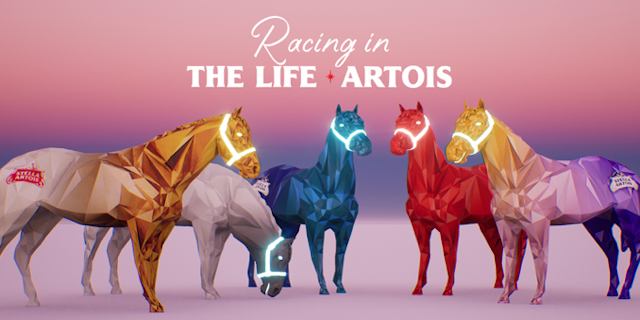Can NFTs sell more Stella Artois? Brewer AB InBev thinks so
AB InBev, the multinational brewer behind Budweiser and Stella Artois, has been experimenting in the virtual world with its first NFT purchases. The company’s global head of innovation explains how the metaverse, cryptocurrencies and blockchain horse racing can boost beer sales.

AB InBev recently gave Stella Artois a metaverse debut
Beer is not enough for Budweiser. Earlier this month, the king of beers pivoted from alcohol to art with the purchase of its first non-fungible token artworks (NFTs).
The pieces, created by artist Tom Sachs, were displayed as the profile picture on Budweiser’s Twitter account, and were an ‘entry point’ for the brand into the world of digital art collecting, according to Lindsey McInerney, global head of technology and innovation at AB InBev, the company which brews Budweiser, Stella Artois and Corona.
McInerney joined the company in 2019 and was given a brief to bring new technologies and ideas to the international brewer last year. “A place I’ve been spending a lot of time in is ’Web 3’, and the technologies that are going to underpin some of it, such as crypto, blockchain, the metaverse. It is going to change and rock every company on the planet,“ she says.
For the uninitiated, ’Web 3’ refers to the next iteration of the world wide web – an evolution from the days of web pages (the first iteration) or social networks (’Web 2.0’) to a realm of virtual landscapes, avatars, brands and people interacting within one, or many, metaverses – all underpinned by blockchain technologies such as cryptocurrency transactions and NFTs.
Under her auspices, Stella Artois became the first FMCG brand to enter the metaverse in June, teaming up with blockchain gaming platform Zed Run to auction off 50 digital skins for a virtual horse racing competition.

“My thesis is that brands could replicate in the metaverse what they do well in reality. In reality, we’re the world’s largest sponsor of sport, media and entertainment. We bring people together to be delighted and entertained and to socialize. There are these new worlds emerging, new concepts emerging, for what sport looks like, so now we’re doing that identical thing in the metaverse.
“[Zed Run] is the most premium sporting platform in the metaverse and it is growing like crazy. It was a really natural fit for us.“
All well and good. But how does it sell more Stella?
Blockchain beer
“Marketers love to be where people are,“ answers McInerney. Activations within the metaverse, she predicts, will soon “parallel the traditional marketing taxonomy ... with advertising, sponsorships, experiential marketing, direct-to-consumer e-commerce.“
“There will genuinely be opportunity to sell beer from the metaverse. There’s no doubt in my mind that there will be opportunity to sell products. But moreover, there’s the opportunity to be where your customers are and surprise and delight them, and give them experiences that are unmatched.“
These are early days for AB InBev’s initial activations, and in McInerney’s estimation, the metaverse itself. Its efforts have been executed in-house, and though she declines to share how much AB InBev has so far invested in its blockchain experiments, its Tom Sachs NFT purchases set it back 8 ETH – about $25,000 in old money. For a company with a marketing budget of billions, it’s loose change.
McInerney practices what she preaches. ”I invest, I buy NFTs and I’m participating in Discord channels and on Twitter and in crypto and all of these sorts of things, because it’s the best way to really see what the opportunity is ahead,” she says. Displayed behind her, as she speaks to The Drum via Zoom, is a print made from an NFT artwork McInerney invested in, from the Bored Ape Yacht Club – a gurning, haloed chimpanzee wearing a striped T-shirt.
“It’s a piece of art that I love, it’s a piece of art that I feel represents me and my headspace really well.“
She compares the current moment to the birth of social media in the noughties. “We’re seeing a really similar thing happen right now, where brands are again starting to wonder: is there a spot for us here? We bring people together in reality for a better world, and there are more worlds emerging. So our mission to bring people together just got bigger.
“There will be new companies similar to those that disrupted the world, the way business is done, in Web 3. And brands who aren’t thinking about that right now will fall behind, no question. The next five to 10 years are going to be monumental in how we interact digitally.“
Carbon impact
So far, AB InBev has launched its forays into the metaverse hand-in-hand with partners such as Zed Run. Although it doesn’t own or operate any blockchain infrastructure directly, marketing activations created using blockchain technologies still carry a carbon footprint. Blockchain tech, such as Bitcoin or NFTs, has been associated with high energy costs and a heavy toll in carbon emissions. Can the company, which promised in 2018 to reduce CO2 emissions across its entire supply chain by 25%, justify its experiments?
McInerney is optimistic that it can: “There are a number of people exploring solutions to this problem right now. Crypto isn’t going away, blockchain is not going away ... you’ve got a lot of very intelligent people invested in solving that problem ... making sure that it’s being done in a way that is sustainable for businesses and consumers alike.
“Like any new technology, it’s got its ups and downs and challenges that absolutely have to be overcome. We’ll get there with blockchain.“
In the meantime, she sees further opportunities open to AB InBev’s brand portfolio. Stella Artois’ existing sports sponsorships led it to virtual horse racing, and McInerney points to Budweiser’s long-standing association with American football as a similarly fruitful link. The beer brand’s famous Clydesdale horses could make a virtual appearance, for instance.
But the possibilities, McInerney says, don’t need to end with the obvious. Consider Leffe – a Belgian abbey beer which, with its high alcohol content, gold foil wrapping and steep price, occupies a niche in AB InBev’s hundreds-strong brand library. She says its traditional and premium trappings shouldn’t stop it minting an NFT, for instance.
“Honestly, I think there’s an opportunity for every brand to explore the metaverse, to explore how they can leverage NFTs, to build more loyal and engaged communities around their product. Imagine you could own an NFT that gave you access to explore certain monasteries, whether digitally or physically, and brought you together with others to drink exclusive cask beers once a year from Leffe. I think that there are plenty of really creative and interesting stories to tell.
“Great brands are masters of storytelling. And this is just a new medium to be able to tell those stories.“

